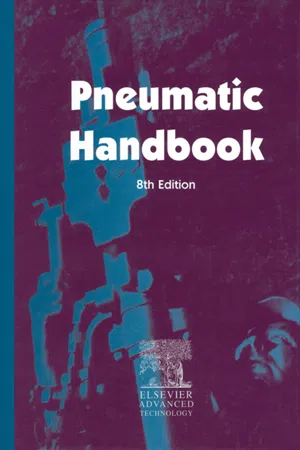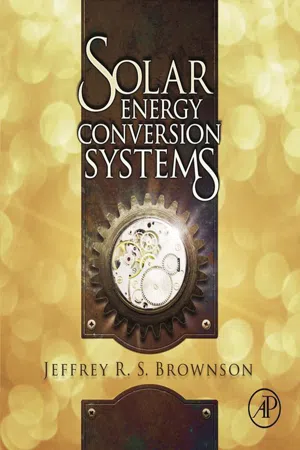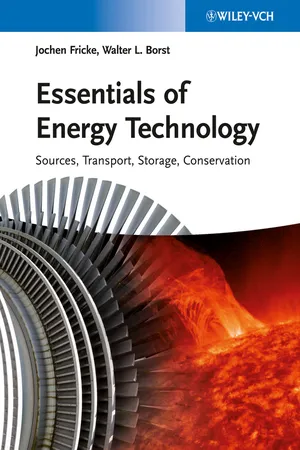Technology & Engineering
Isentropic Efficiency
Isentropic efficiency is a measure of how effectively a process or device can convert input energy into useful work without incurring losses. It is often used in thermodynamics and fluid mechanics to assess the performance of compressors, turbines, and nozzles. A higher isentropic efficiency indicates a more efficient conversion of energy.
Written by Perlego with AI-assistance
Related key terms
Related key terms
1 of 4
Related key terms
1 of 3
4 Key excerpts on "Isentropic Efficiency"
- eBook - ePub
- V. Babu(Author)
- 2019(Publication Date)
- CRC Press(Publisher)
2 , the reduction in kinetic energy required to diffuse the flow to the same exit pressure is less in an isentropic process. In other words, for a given decrease in the kinetic energy, the pressure rise is more in an isentropic process when compared to an adiabatic irreversible process.EXAMPLE 9.12Calculate the Isentropic Efficiency of the turbine in Example 9.9.Solution : At the end of an isentropic expansion to the same exit pressure, P2s= 10 bar and s2s= s1 = 6.5404 kJ/kg.K. From Table B , with sf = 2.1387 kJ/kg.K and sg = 6.5861 kJ/kg.K, it is clear that, state 2s is in the mixture region. The dryness fraction may be evaluated asx=2 s= 0.9897s−2 ss fs g−s fFrom Table B , with hf = 762.8 kJ/kg and hg = 2777.7 kJ/kg, the specific enthalpy at state 2s, is given asTherefore, the Isentropic Efficiencyh=2 sh f+x(2 sh g−h f) = 2756.95 k J / k gη t== 0.89h 1−h 2h 1−h2 sEXAMPLE 9.13Calculate the Isentropic Efficiency of the compressor in Example 9.10.Solution : At the end of an isentropic compression process to the same pressure, we have P2s= 700 kPa, s2s= s1 = 0.9345 kJ/kg.K. This is a superheated state. From Table F , we can retrieve h2s= 269.45 kJ/kg after interpolation. Therefore, the Isentropic Efficiencyη c== 0.71h−2 sh 1h 2−h 1EXAMPLE 9.14Calculate the Isentropic Efficiency of the nozzle in Example 9.11.Solution : At the end of an isentropic expansion process to the same pressure, we have P2s= 1 bar, s2s= s1 = 7.5273 kJ/kg.K. This is a superheated state. From Table C , we can retrieve h2s - eBook - ePub
- A. Barber(Author)
- 1997(Publication Date)
- Elsevier Science(Publisher)
T is the temperature of the air at the point of use, which can be any value between ambient and compressor delivery. If air can be used at high temperature, there is more potential power available but, as with conventional systems, the temperature normally falls to the ambient either in the receiver or in its passage along the distribution mains.The definition of potential efficiency follows from potential power: Isentropic power has been chosen as the denominator, but any calculation of power can be used – isothermal if the compressor works on that cycle or polytropic if the index of compression is known. Now since isentropic power is given by the potential efficiency becomes:[3]T is normally equal to T2 , but the expression indicates that if the air can be used at a higher temperature than ambient, the efficiency is improved. This is rarely likely to be possible in practice, but if circumstances are such that it can be used in that way, there are advantages to be gained. The second conclusion to be drawn from this expression is that the efficiency is a function of pressure ratio.A plot of the potential efficiency is given in Figure 1 .FIGURE 1 – Variation of compressor efficiencies with pressure ratio for two level mode.On the same figure is a plot of the overall efficiency measured from experiments performed at FPC on a modified vane compressor. The overall efficiency, taking into account mechanical losses in the compressor drive, is rather less than the potential efficiency.When comparing theoretical efficiency with the overall efficiency, it appears that the mechanical efficiency alone is of the order of 67%. On the face of it this seems rather lower than one would expect, but the values are obtained at an early stage in the development of the concept, and it is likely that they would improve with experience. - eBook - ePub
- Jeffrey R. S. Brownson(Author)
- 2013(Publication Date)
- Academic Press(Publisher)
3(A.2)(A.3)where the temperatures T H and T L are given in degrees Kelvin (K, not °K).Figure A.1: Schematic of the energy conversion device: heat engine. Arrows indicate currents, or fluxes of energy or entropy.We shall see in the next Appendix that the Carnot limit based on temperature is a special case of efficiency, historically bound by our tradition of an internal combustion engine, and assuming losses were all due to friction (implying a mechanical form of energy in the initial state) with an upper limit to temperature respective of the housing of the engine (a materials constraint, not a limit of thermodynamics!). In fact, we can identify that ideal efficiencies will be more appropriately defined in terms of the flux of entropy generation and more generic definitions of temperature, to better encompass physical devices such as fuel cells that do not follow the thermal and frictional constraints of a Carnot heat engine.4In contrast, a heat pump is an energy moving device that must work against the natural tendency for high-to-low flow and increasing entropy as seen in Figure A.2 . The pump requires work to collect and organize low temperature energy from the reservoir source to the high temperature system sink. Again, we have a classic special case for a heat pump that constrains the general definition. The special case is for work applied via electricity to move heat. The figure of merit for a heat pump is termed the Coefficient of Performance (CoP) . This is the ratio of the energy transferred for moving energy from low to high relative to the input energy as work (Eq. (A.4) ). The CoP is the reciprocal and conjugate of the efficiency of a heat engine (η ), and the theoretical maximum can also be related to the Carnot cycle as seen in Eq. (A.5) - eBook - ePub
Essentials of Energy Technology
Sources, Transport, Storage, Conservation
- Jochen Fricke, Walter L. Borst(Authors)
- 2013(Publication Date)
- Wiley-VCH(Publisher)
At present, Stirling engines with a rated power in the low kilowatt range find applications in combined systems for the production of electricity and for heating of houses. Combinations of solar dish concentrators with Stirling engines have been investigated for many years. Stirling engines are being used very successfully in refrigeration systems, for instance, in infrared cameras.3.3 Irreversibilities
The Carnot and idealized Stirling processes apply to infinitely slow, reversible processes. But technical processes generally have to run rather fast. This leads to irreversibilities associated with an increase in entropy. Important examples are the walls of heat exchangers (Figure 3.8 ) that are present in all power plants and heating systems.Figure 3.8Infinitely large planar wall of a heat exchanger with surface temperatures T and T − ΔT and surrounding temperature Tsurr . Heat dQ enters and leaves the wall. Associated with dQ is the entropy dSh on the hot side and dSc on the cold side.Under stationary conditions, energy conservation implies that dQ entering the left is the same as dQ leaving the right side. As the heat enters the wall at the temperature T and leaves it at T − ΔT, an entropy increase has occurred:3.5This shows that the greater the temperature change ΔT in the wall for a given dQ, the larger the entropy increase. In order to reduce the entropy production, one therefore would have to reduce ΔT and/or raise the temperature T. But keeping the throughput dQ the same with a smaller ΔT would require a larger surface of the heat exchanger. This is not practical in most cases and corresponding entropy increases hence are unavoidable. Actually, heat exchangers are built as compact as possible in order to minimize the amount of steel and the required building volume, irrespective of entropy considerations.3.4 Exergy and Anergy
In addition to the concept of entropy, engineers have used a quantity named exergy in order to characterize the efficiency of devices. By using the Carnot efficiency in Eq. (3.1 ), the exergy Ex , measured in joules, is related to the heat Q at temperature Th as follows:3.6where Tsurr is the temperature of the surroundings in which the device works, for instance, Tsurr ≈ 300 K. The fractional exergy content in Q
Index pages curate the most relevant extracts from our library of academic textbooks. They’ve been created using an in-house natural language model (NLM), each adding context and meaning to key research topics.
Explore more topic indexes
Explore more topic indexes
1 of 6
Explore more topic indexes
1 of 4



